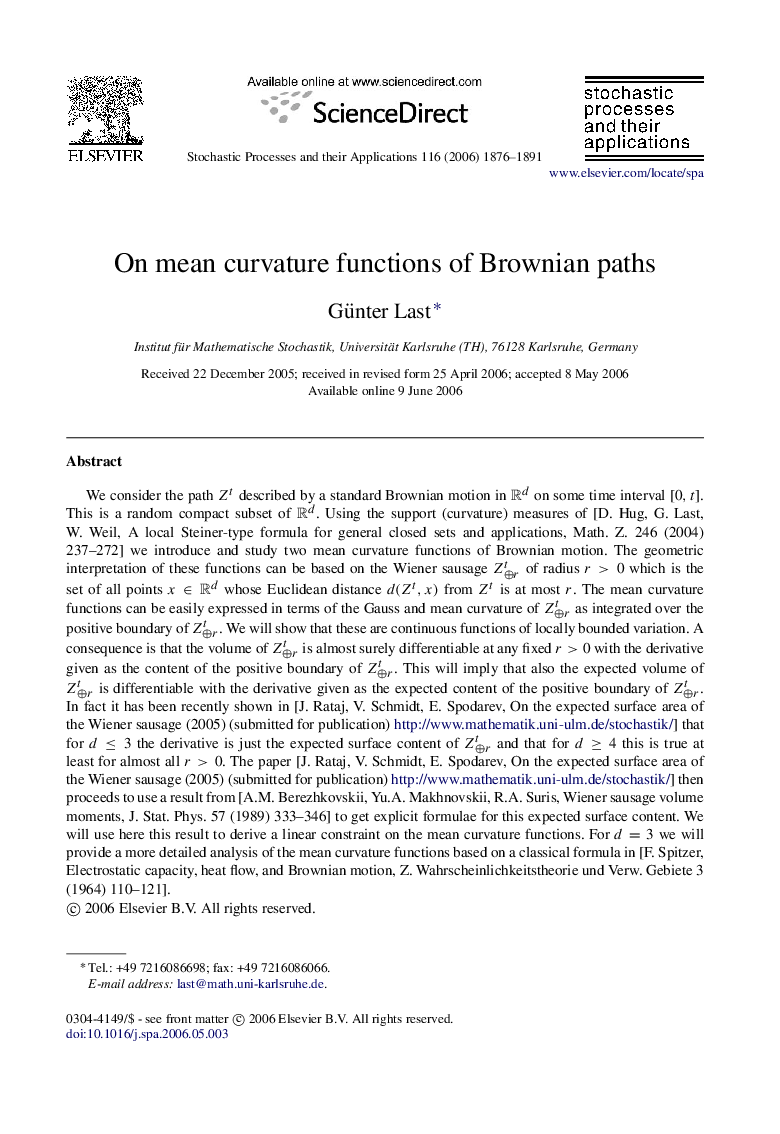| Article ID | Journal | Published Year | Pages | File Type |
|---|---|---|---|---|
| 1157084 | Stochastic Processes and their Applications | 2006 | 16 Pages |
We consider the path ZtZt described by a standard Brownian motion in RdRd on some time interval [0,t][0,t]. This is a random compact subset of RdRd. Using the support (curvature) measures of [D. Hug, G. Last, W. Weil, A local Steiner-type formula for general closed sets and applications, Math. Z. 246 (2004) 237–272] we introduce and study two mean curvature functions of Brownian motion. The geometric interpretation of these functions can be based on the Wiener sausage Z⊕rt of radius r>0r>0 which is the set of all points x∈Rdx∈Rd whose Euclidean distance d(Zt,x)d(Zt,x) from ZtZt is at most rr. The mean curvature functions can be easily expressed in terms of the Gauss and mean curvature of Z⊕rt as integrated over the positive boundary of Z⊕rt. We will show that these are continuous functions of locally bounded variation. A consequence is that the volume of Z⊕rt is almost surely differentiable at any fixed r>0r>0 with the derivative given as the content of the positive boundary of Z⊕rt. This will imply that also the expected volume of Z⊕rt is differentiable with the derivative given as the expected content of the positive boundary of Z⊕rt. In fact it has been recently shown in [J. Rataj, V. Schmidt, E. Spodarev, On the expected surface area of the Wiener sausage (2005) (submitted for publication) http://www.mathematik.uni-ulm.de/stochastik/] that for d≤3d≤3 the derivative is just the expected surface content of Z⊕rt and that for d≥4d≥4 this is true at least for almost all r>0r>0. The paper [J. Rataj, V. Schmidt, E. Spodarev, On the expected surface area of the Wiener sausage (2005) (submitted for publication) http://www.mathematik.uni-ulm.de/stochastik/] then proceeds to use a result from [A.M. Berezhkovskii, Yu.A. Makhnovskii, R.A. Suris, Wiener sausage volume moments, J. Stat. Phys. 57 (1989) 333–346] to get explicit formulae for this expected surface content. We will use here this result to derive a linear constraint on the mean curvature functions. For d=3d=3 we will provide a more detailed analysis of the mean curvature functions based on a classical formula in [F. Spitzer, Electrostatic capacity, heat flow, and Brownian motion, Z. Wahrscheinlichkeitstheorie und Verw. Gebiete 3 (1964) 110–121].
